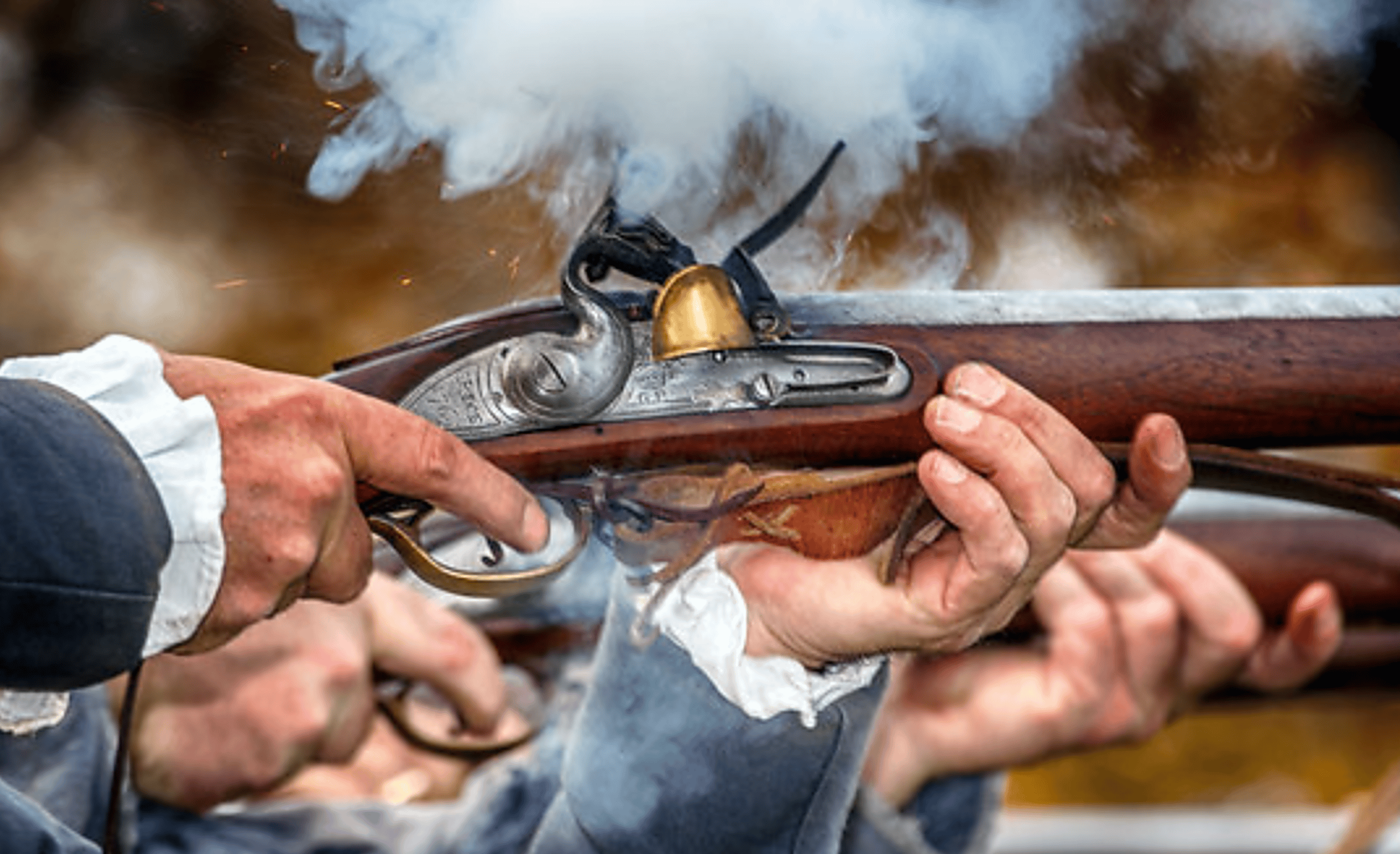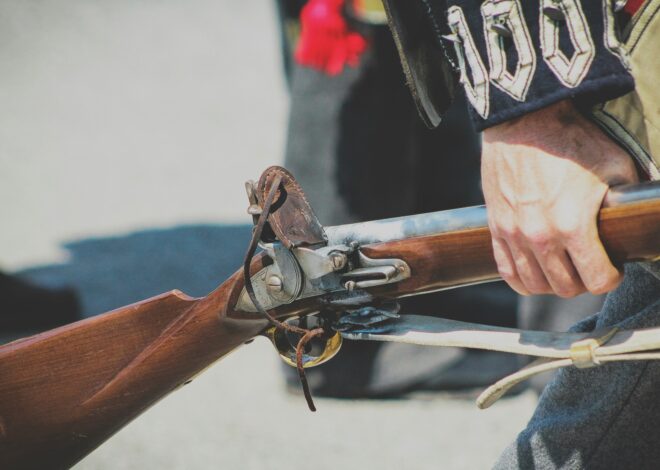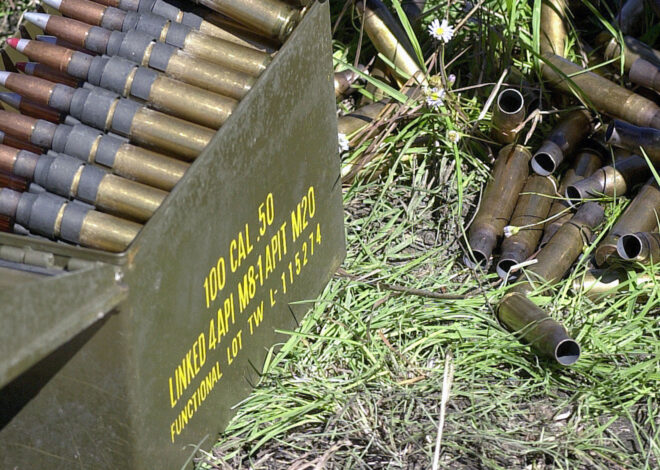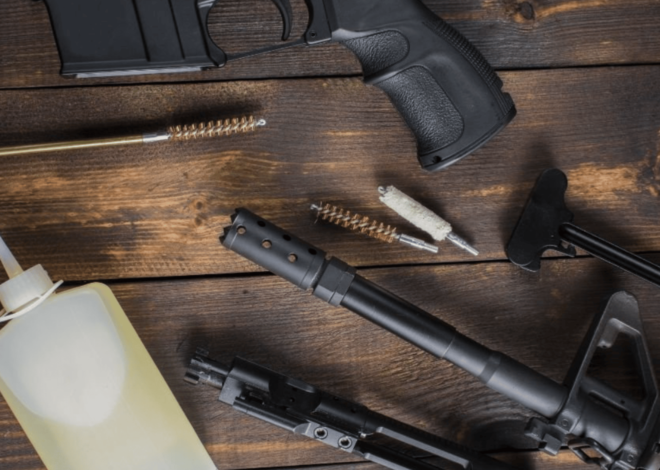
How To Load And Shoot A Musket
Whether you’re drawn to its significance on the battlefield or simply intrigued by its mechanics, learning how to load and shoot a musket can offer a unique blend of challenge and satisfaction.
The musket, a firearm steeped in history and tradition, has captured the imagination of enthusiasts for centuries. This ancient weapon requires skill and precision—qualities that resonate with many who seek to connect with the past.
In this guide, we’ll walk you through each step of loading and firing a musket, providing insights into everything from safety precautions to aiming techniques. Ready your supplies and prepare for an adventure into historical marksmanship where every shot tells a story!
Understanding the Parts of a Musket
A musket is a fascinating piece of history, and understanding its parts can enhance your shooting experience. At the heart of it all is the barrel, where the combustion occurs and propels the projectile forward.
Running along the length of this metal tube is the rifling, which helps spin the bullet for better accuracy. The muzzle is at one end; that’s where you load in everything needed to fire.
Next up is the stock—the wooden part you hold onto. It provides stability when aiming and shooting.
The lock mechanism ignites gunpowder when you pull the trigger. This includes vital components like flint or percussion caps, depending on your musket type.
Don’t overlook accessories such as ramrods and powder measures. Each element plays a crucial role in ensuring your musket functions correctly while contributing to its rich history.
Safety Precautions for Handling a Musket
Handling a musket requires utmost caution. Always treat it as if it is loaded, even when you believe it’s not. This mindset fosters respect and vigilance.
When moving with the musket, keep the muzzle pointed in a safe direction—away from people and structures. Accidental discharge can lead to serious consequences.
Wear appropriate protective gear. Safety glasses shield your eyes from debris, while ear protection guards against loud gunfire sounds.
Before loading, ensure you’re in a controlled environment free of distractions. Clear communication with others around you is essential for safety during handling.
Never leave a loaded musket unattended. If you need to step away or take breaks, unload it first to prevent any potential mishaps.
Familiarize yourself with local laws regarding firearms usage and storage. Compliance ensures that you’re not only safe but also legally responsible while enjoying this historical pastime.
Step-by-Step Guide to Loading a Musket
Loading a musket requires precision and care. So let’s get started:
Step 1: Prepare Your Materials and Tools
Before you dive into loading your musket, it’s essential to gather all necessary materials and tools. This preparation sets the stage for a smooth experience.
Start with gunpowder. Make sure you have the right type and quantity for your specific musket model. A reliable powder measure can help ensure accuracy in your loading process.
Next, you’ll need projectiles. Round balls or conical bullets are common choices. Choose one that fits snugly within the barrel’s dimensions.
Don’t forget wadding or patches; these create a seal between the powder and projectile for better performance.
Have cleaning tools on hand—ramrods, brushes, and lubricants will keep everything in top condition during use. Having all equipment ready allows you to focus entirely on mastering the art of shooting a musket without unnecessary interruptions later on.
Step 2: Inspect and Clean the Musket
Before loading your musket, it’s crucial to inspect and clean it. A well-maintained musket ensures safety and optimal performance.
Start by checking the barrel for any obstructions or rust. Use a flashlight if needed to illuminate hard-to-see areas. If you find debris, carefully remove it with a cleaning rod.
Next, look over the lock mechanism. Ensure that all parts move smoothly without friction or resistance. Any signs of wear could affect firing reliability.
Cleaning is essential too. Run a damp patch through the barrel to remove residue from previous shots. Follow this with dry patches until they come out clean.
Lubricate moving parts sparingly with proper oil—this helps prevent corrosion while ensuring smooth operation when it’s time to fire again. Taking these steps not only enhances accuracy but also extends the life of your firearm significantly.
Step 3: Measure and Pour Gunpowder into the Barrel
Measuring and pouring gunpowder is a critical step in loading a musket. Precision matters here; using the right amount ensures optimal performance.
Start by selecting a reliable powder measure. This tool helps you gauge the exact quantity needed, typically around 60 to 100 grains for most muskets.
Once you’ve measured out your powder, carefully pour it into the barrel’s opening. Avoid spills—gunpowder is sensitive and should be treated with respect.
As you pour, maintain focus on your surroundings. Ensure there are no sparks or open flames nearby. Safety must always come first when handling this explosive material.
After pouring, gently tap the barrel to settle the powder at the bottom. This action guarantees an even distribution which aids in achieving consistent firing results later on, setting up for success as you proceed with loading your musket.
Step 4: Place a Wad or Patch Over the Powder
Once you’ve poured the gunpowder into the barrel, it’s time to add a wad or patch. This step is crucial for ensuring optimal performance when firing your musket.
Wads are typically made from materials like felt or cardboard. They help seal the chamber and prevent any gas from escaping when the musket is fired. A snug fit enhances accuracy and consistency in every shot.
If you’re using a cloth patch, it should be slightly larger than your projectile. This allows it to engage with both the powder and the ball effectively. It also serves to provide lubrication if you pre-soak it with an appropriate oil or grease.
Carefully place your chosen wad or patch over the powder without disturbing it too much. A gentle touch here ensures everything remains aligned for what’s coming next—loading in that all-important projectile!
Step 5: Insert Projectile into the Barrel
With your wad securely in place, it’s time to insert the projectile. This is a crucial step that requires precision and care.
Carefully select the appropriate projectile for your musket. Common options include lead balls or minie balls, depending on what you’re using. Ensure it fits snugly within the barrel — too tight will make loading difficult; too loose can affect accuracy.
Gently drop the projectile down the muzzle of the barrel. Avoid forcing it, as this could damage both the ball and your firearm.
Once it’s inside, take your ramrod and position it above the projectile. In one smooth motion, push downwards until you feel resistance from where you’ve already packed in powder and wad.
Ensuring that everything is seated properly is critical for an effective shot later on. Each component works together as part of a larger mechanism designed for performance.
Step 6: Ram Down the Projectile with a Ramrod
Once you’ve placed the projectile into the barrel, it’s time to ram it down securely. This step is crucial for ensuring that your shot will be accurate and powerful.
Using a ramrod, insert it gently into the muzzle. Apply even pressure as you push down on the ball or bullet. You want to avoid damaging both the projectile and the interior of your musket.
Feel for resistance as you reach the powder charge. It’s important to ensure everything fits snugly without forcing anything too hard. A proper fit prevents misfires and enhances accuracy.
Keep an eye on your technique here; a steady hand goes a long way in maintaining control during this process. Once secured, you’re ready to move onto priming and firing, bringing you closer to experiencing traditional musket shooting firsthand!
Step 7: Priming and Firing the Musket
With the musket loaded, it’s time to prime and fire. This step is crucial for a successful shot. You’ll need priming powder, which is finer than the main charge.
Carefully pour a small amount of this powder into the pan located on top of the lock mechanism. Make sure it fills but doesn’t overflow — precision matters here.
Next, ensure your firing mechanism is in good working order. Check that both the flint and frizzen are properly positioned.
Now you’re ready to take aim. Keep your focus steady while holding your breath briefly before pulling the trigger.
As you squeeze gently, feel anticipation build as the musket fires with a satisfying boom! Smoke will billow from both ends as you experience what many have felt throughout history—powerful yet respectful towards such an iconic weapon.
Advanced Techniques for Faster Loading
Mastering the art of loading a musket can enhance your shooting experience. Advanced techniques streamline this process, saving valuable time.
One method is pre-measuring gunpowder using a powder flask with adjustable spouts. This allows for quick pouring without fumbling with scales each time you load.
Another approach involves using specialized ramrods fitted with speed loaders. These tools help to seat projectiles quickly and efficiently, ensuring proper alignment in the barrel.
Practicing consistently also improves your muscle memory. As you become familiar with each step, you’ll find that your motions become more fluid and natural.
Consider practicing in situations that simulate real conditions. Speed and accuracy under pressure are crucial skills when it comes to effective shooting of muskets.
Safety Tips for Loading a Musket
When loading a musket, safety should always be your top priority. Start by ensuring you’re in a controlled environment. Avoid crowded areas and choose a well-ventilated space away from flammable materials.
Wear appropriate protective gear, including safety glasses and gloves. This will shield you from any accidental sparks or debris during the loading process.
Always keep the muzzle pointed in a safe direction. Treat every musket as if it is loaded—this mindset can prevent tragic accidents.
Be mindful of your surroundings while handling the gunpowder and projectiles. Make sure there are no distractions; focus on each step to maintain accuracy and control.
Never rush through the loading process. Take your time to ensure everything is done correctly, without shortcuts that might lead to mishaps later on.
Keep all ammunition stored securely when not in use. Proper storage prevents unauthorized access or accidents with young individuals nearby.
Tips for Properly Aiming and Shooting a Musket
Aiming a musket requires focus and precision. Here are two steps that will make you a better shot in no time at all.
Tip 1: Proper Stance and Grip for Shooting a Musket
Achieving a proper stance is crucial when shooting a musket. Stand with your feet shoulder-width apart, ensuring stability. Your dominant foot should be slightly behind the other, providing balance and control.
Next, focus on your grip. Use your dominant hand to hold the stock firmly but comfortably. Keep your trigger finger outside the trigger guard until you’re ready to fire. This helps prevent accidental discharges.
Your non-dominant hand should support the barrel or forend of the musket. This gives you additional stability while aiming.
As you prepare to shoot, lean slightly forward from your hips without compromising balance. A relaxed body posture enhances accuracy by absorbing any recoil effectively.
Remember that breathing plays a vital role as well. Take deep breaths and exhale slowly before taking your shot, allowing for greater concentration and steadiness in aim.
Tip 2: Aiming Techniques for Improved Accuracy
Aiming is crucial for effective musket shooting. Begin by aligning your eye with the sights. Your dominant eye should focus directly on the target while keeping both eyes open to maintain peripheral awareness.
Next, use the front sight as a reference point. Ensure it’s aligned with your target and level across your sights. This alignment helps in achieving precision shots.
Consider breathing techniques too. Take a deep breath, then exhale halfway before squeezing the trigger gently. This steadies your aim and reduces involuntary movements.
Your body posture plays an essential role as well. Stand firmly, distributing weight evenly between both feet for stability during each shot. Adjusting these elements can dramatically enhance accuracy when using a musket in practice or competition situations.
Common Mistakes to Avoid When Using a Musket
When using a musket, one of the most frequent mistakes is rushing through the loading process. Patience is key; hasty actions can lead to misfires or accidents.
Another common error involves neglecting proper cleaning. A dirty barrel can disrupt accuracy and performance. Always ensure your musket is clean before use.
Failing to adhere to safety protocols often leads to dangerous situations. Always treat a musket as if it’s loaded, even when you believe it isn’t.
Improper stance and grip are also critical pitfalls that can affect shooting precision. Take time to find what feels balanced and comfortable for you.
Overlooking environmental factors like wind direction can impact your shot significantly. Recognizing these elements will enhance your shooting experience dramatically.
History and Significance of the Musket in Warfare
The musket emerged as a game-changer in warfare during the 16th century. It revolutionized how battles were fought, shifting power dynamics across Europe and beyond. With its ability to deliver lethal projectiles at greater distances than traditional weapons, the musket became essential for infantry tactics.
As armies adapted to this new technology, formations evolved. Soldiers learned to line up and fire volleys, maximizing their effectiveness against enemy troops. The consequences were profound; battlefields transformed into deadly arenas where strategy reigned supreme.
Beyond its tactical significance, the musket also symbolized social change. It democratized combat by enabling common soldiers to wield considerable power previously reserved for knights or cavalry. This shift played a vital role in shaping modern military traditions and even influenced political movements that followed.
The legacy of the musket is evident today in various firearm designs while reminding us of an era when precision and discipline defined warfare.
Conclusion: The Art & Skill of Using a Musket in Modern Times
The art of loading and shooting a musket is not just about pulling the trigger; it’s a blend of history, skill, and technique that connects us to our past. Mastering this process requires patience and practice, but the rewards are immense.
With each step in loading—from preparing your materials to properly aiming—you engage with traditions that date back centuries. This connection enhances the experience, making every shot fired resonate with historical significance.
While modern firearms have overtaken muskets in speed and efficiency, there remains an undeniable charm in using these classic weapons. Whether for reenactments or personal enjoyment, understanding how to load and shoot a musket is an invaluable skill that honors our heritage.
As you delve deeper into this fascinating world, remember that safety is paramount. Respect for both equipment and surroundings ensures a rewarding experience without unnecessary risks. Embrace the challenge—it’s more than just firing a weapon; it’s participating in history itself.
Whether you’re drawn by curiosity or passion for historical accuracy, learning how to handle a musket opens doors to unique experiences. Each time you take aim down the barrel of your musket can evoke admiration not only for craftsmanship but also for those who wielded such tools throughout history’s many chapters.







That’s the first time I read about guns on this platform and I’m grateful because I’m learning new things! Here in France, we’re not allowed to have guns, unless we work in specific trades (e.g. police, army) or if you have special authorizations (for example, you’re a professional hunter). So it’s always interesting to see that you can have guns in other cultures! And yes, when you handle a musket, you must be careful and be aware of safety.
Hi Angelce903,
Thank you for stopping by and sharing your thoughts with us today. When handling a musket or any other firearm, safety must always come first. Just so you know, if you click on the Weaponry category, I have many more posts about firearms. If you want to learn more about guns, this is the website for you. Thanks again for visiting with us today!
Best wishes,